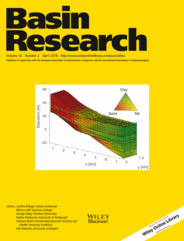
Full text loading...
 , Cari L. Johnson1
, Cari L. Johnson1 , Michael Stearns1
, Michael Stearns1
The Turonian‐Coniacian Smoky Hollow Member of the Straight Cliffs Formation in the Kaiparowits basin of southern Utah records a stratigraphic transition from isolated fluvial channel bodies to increasingly amalgamated channel belts capped by the Calico bed, a sheet‐like sand‐gravel unit. Characteristics of the Smoky Hollow Member are consistent with a prograding distributive fluvial system including: up‐section increases in average grain size, bed thickness, channel‐body amalgamation, a fan‐shaped planform morphology and a downstream increase in channel sinuosity. The system prograded to the northeast based on thickness and facies patterns, and palaeocurrent indicators. This basin‐axial sediment‐dispersal trend, which was approximately parallel to the fold‐thrust belt at this latitude, is supported by provenance data including detrital zircons and modal sandstone compositions indicating sediment derivation mainly from the Mogollon Highlands and Cordilleran magmatic arc to the southwest, with episodic input from the more proximal Sevier fold‐thrust belt to the west. Progradation occurred during a eustatic still‐stand, relatively stable climatic conditions, and continuous tectonic subsidence, thus suggesting increased extrabasinal sediment supply as a primary control on basin‐fill. Progradation of the Smoky Hollow Member fluvial system culminated in a ~2–3 My hiatus at the top of the lower Calico bed. Correlation with the Notom delta of the Ferron Sandstone, 80 km northeast in the Henry basin, is proposed on the basis of facies relationships and geochronology. The Calico bed unconformity is linked to regional tectonically driven tilting and erosion observed in both basins.

Article metrics loading...

Full text loading...
References


Data & Media loading...
Supplements

